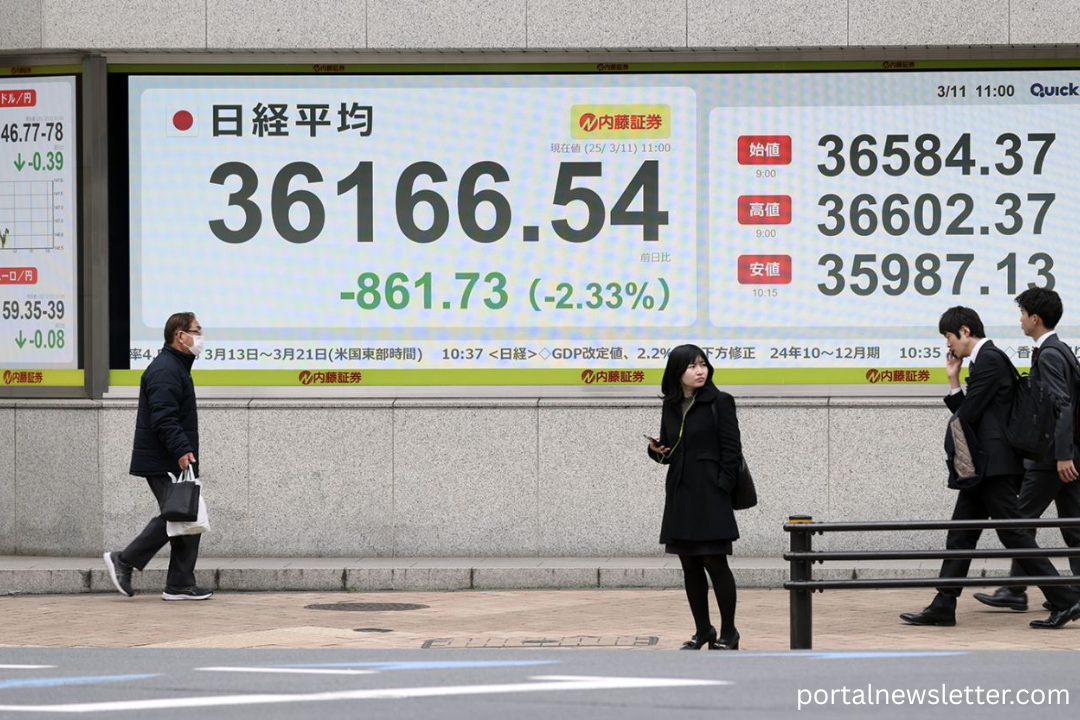Asia stocks experienced modest gains despite persistent concerns over global trade tensions. Market movements across major Asian economies reflected a cautious optimism as investors tried to balance hopes for economic recovery with ongoing uncertainties surrounding trade policies. With volatility remaining a key factor, Asia stocks continue to capture the attention of traders and analysts around the world.
Overview of Asia Stocks Performance
Asia stocks posted slight gains as markets reacted to mixed signals on international trade talks, particularly between the United States and China. Significant indexes such as Japan’s Nikkei 225, Hong Kong’s Hang Seng Index, and South Korea’s KOSPI showed small upward trends during early trading hours. This positive movement suggests that while concerns remain, investors are finding reasons to cautiously re-enter the market.
China’s Shanghai Composite Index also ticked higher, buoyed by some signs of stabilization in manufacturing activity. However, analysts caution that Asia stocks remain sensitive to the subsequent developments in global trade relations.
Factors Influencing Asia Stocks
Several factors are currently impacting Asia stocks. Chief among them are the ongoing negotiations and tensions between major global economies. The trade war between the US and China, although showing periods of thawing, has yet to reach a definitive resolution. Any signs of progress or setbacks directly influence the volatility and direction of Asia stocks.
Additionally, internal economic data from countries such as China, Japan, and South Korea are closely watched. Stronger-than-expected GDP growth, consumer spending figures, or industrial production numbers tend to boost confidence in Asia stocks, while weaker reports fuel concerns about a broader economic slowdown.
Currency movements also play a crucial role. A weakening dollar can make Asia stocks more attractive to foreign investors, whereas a strengthening dollar might pull investments away from the region.
Impact of US Trade Policy on Asia Stocks
US trade policy remains one of the primary external factors influencing Asia stocks. Shifting statements and inconsistent negotiations contribute to uncertainty, making investors cautious. When positive developments are announced, Asia stocks tend to rise as risk appetite returns. Conversely, any escalation or new tariffs can quickly dampen market sentiment.
Recent announcements from US officials hinting at further delays in resolving trade agreements added new layers of complexity. As a result, Asia stocks saw only moderate gains rather than a full-scale rally.
Market analysts suggest that until there is a clear and lasting agreement on trade, Asia stocks will continue to experience periods of volatility driven by geopolitical headlines.
Sector-wise Analysis in Asia Markets
Specific sectors within Asian stocks have performed better than others despite the overarching trade fears. Technology stocks, for instance, have shown resilience, particularly companies involved in semiconductors and consumer electronics.
The healthcare and consumer goods sectors have also remained relatively stable, as the demand for essential goods is less affected by trade tensions. Meanwhile, export-reliant industries such as automotive and heavy manufacturing have seen more significant pressure, reflecting the global trade uncertainty weighing on Asia stocks.
Financial services in Asia have shown mixed results. Banks benefit from increased lending activity but face challenges from global interest rate fluctuations.
Investor Sentiment and Asia Stocks
Investor sentiment towards Asia stocks remains cautious but not entirely negative. Many institutional investors believe that Asia stocks offer attractive valuations compared to their Western counterparts, particularly in emerging markets like Vietnam, Indonesia, and Malaysia.
Risk appetite has returned in short bursts whenever there is positive news on trade negotiations or signs of domestic economic resilience. Nevertheless, given the lingering trade fears, portfolio managers are recommending a diversified approach to investing in Asian stocks.
Short-term traders are capitalizing on volatility, while long-term investors are carefully selecting sectors and countries with strong fundamentals to weather potential storms.
Government and Central Bank Responses
Governments and central banks across Asia have implemented various measures to support their economies, directly impacting Asia stocks. Interest rate cuts, fiscal stimulus packages, and infrastructure investment initiatives are among the tools being used to bolster economic growth.
China’s central bank, for example, has introduced liquidity injections to stabilize financial markets, while Japan continues its accommodative monetary policy to spur investment and consumption. These moves have created a somewhat supportive backdrop for Asia stocks, even amid external pressures.
Policymakers in emerging Asian economies are also adopting reforms to attract foreign investment and stimulate domestic industries, further enhancing the long-term outlook for Asia stocks.
How Asia Stocks Compare to Other Markets
Compared to Western markets, Asian stocks offer a unique combination of growth potential and risk. While US and European markets face their challenges, Asian stocks present opportunities driven by a growing middle class, technological advancements, and dynamic economic reforms.
However, Asian stocks are also more exposed to global supply chain disruptions and international political tensions. Investors looking to allocate capital to Asian stocks must carefully balance these factors.
Recent data show that although Asia stocks have underperformed US equities over the past year, they are beginning to attract renewed interest as global investors seek to diversify away from overvalued American markets.
Predictions for Asia Stocks in the Coming Months
Looking ahead, analysts predict that Asia stocks will remain sensitive to trade headlines and economic data releases. If trade relations improve and global demand recovers, Asia stocks could see more substantial and more sustained growth.
Key events to watch include future U.S.-China negotiations, earnings reports from major Asian corporations, and policy changes in major economies like Japan and India.
Long-term projections remain optimistic for Asia stocks, particularly in emerging markets and technology sectors. However, investors are advised to monitor developments closely and maintain diversified exposure to mitigate risks associated with trade uncertainties.
Tips for Investing in Asia Stocks

Diversification remains crucial for those interested in investing in Asian stocks. Spreading investments across various countries, sectors, and asset classes within Asia can help reduce risk. Investors should pay attention to macroeconomic trends, policy changes, and geopolitical developments. Staying informed about regional differences in growth prospects can also enhance investment strategies focused on Asia stocks.Choosing reputable ETFs (Exchange-Traded Funds) or mutual funds specializing in Asia stocks is a popular way to gain broad exposure without taking on excessive risk tied to individual companies.
Frequently Asked Questions (FAQ’s)
What factors influence Asia stocks?
Several key factors, including global trade relations, economic data from countries like China and Japan, central bank policies, and geopolitical developments, influence Asia stocks. Trade tensions, particularly between the US and China, play a significant role in shaping investor sentiment and stock market movements across Asia.
How do U.S. China trade tensions affect Asia stocks?
U.S.-China trade tensions directly impact Asia stocks by creating uncertainty in global supply chains, affecting export-dependent industries, and influencing investor confidence. Positive developments in trade talks can boost market sentiment, while setbacks tend to lead to declines in Asia stocks.
Are Asia stocks a good investment right now?
Asia stocks offer a mix of growth opportunities and risks. While there are concerns related to global trade and the economic slowdown, many sectors, especially technology and consumer goods, are performing well. Investors interested in Asia stocks should consider diversification and monitor ongoing trade negotiations and economic data.
Which sectors in Asia stocks are performing well despite trade fears?
The technology, healthcare, and consumer goods sectors in Asian stocks are performing relatively well. Technology companies, especially those in semiconductors and electronics, have shown resilience. Meanwhile, the healthcare and consumer goods sectors are less affected by trade tensions, as demand for essentials remains stable.
How do currency fluctuations impact Asia stocks?
Currency fluctuations, particularly in major Asian currencies like the Chinese yuan and the Japanese yen, influence Asia stocks by affecting export competitiveness and foreign investment flows. A weaker currency can make exports more attractive, potentially boosting stock prices, while a stronger currency can have the opposite effect.
What are the long-term prospects for Asia stocks?
Long-term prospects for Asia stocks are optimistic, driven by factors such as a growing middle class, technological innovation, and structural reforms across the region. However, risks related to trade tensions, geopolitical uncertainty, and economic slowdowns must be considered when making long-term investment decisions.
How can investors mitigate risks in Asia stocks?
Investors can mitigate risks in Asia stocks by diversifying their portfolios across different countries, sectors, and asset classes. Staying informed about regional economic trends, trade negotiations, and policy changes is essential. Using ETFs and mutual funds focused on Asia stocks can also help reduce exposure to individual risks.
What should investors watch for in the coming months regarding Asia stocks?
Investors should closely monitor U.S.-China trade talks, economic growth data from key Asian economies, corporate earnings reports, and central bank policies. Key events such as changes in monetary policy or trade agreements can significantly affect Asia stocks in the short to medium term.
Conclusion
Asia stocks have demonstrated resilience amid persistent trade fears, offering cautious optimism to investors. Although volatility remains a defining characteristic of the region’s markets, strategic opportunities exist for those willing to navigate short-term uncertainty. With supportive government policies, attractive valuations, and the potential for long-term growth, Asia stocks continue to be a vital component of global investment portfolios. As the world watches the evolving trade landscape, Asia stocks will undoubtedly remain a focal point for traders and investors alike.


